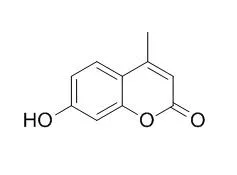| Kinase Assay: |
| Front Immunol. 2015 Mar 23;6:123. | | 4-methylumbelliferone treatment and hyaluronan inhibition as a therapeutic strategy in inflammation, autoimmunity, and cancer.[Pubmed: 25852691] | Hyaluronan (HA) is a prominent component of the extracellular matrix at many sites of chronic inflammation, including type 1 diabetes (T1D), multiple sclerosis, and numerous malignancies. Recent publications have demonstrated that when HA synthesis is inhibited using 4-Methylumbelliferone (4-MU), beneficial effects are observed in several animal models of these diseases. Notably, 4-MU is an already approved drug in Europe and Asia called "hymecromone" where it is used to treat biliary spasm. However, there is uncertainty regarding how 4-MU treatment provides benefit in these animal models and the potential long-term consequences of HA inhibition.
CONCLUSIONS:
Here, we review what is known about how HA contributes to immune dysregulation and tumor progression. Then, we review what is known about 4-MU and hymecromone in terms of mechanism of action, pharmacokinetics, and safety. Finally, we review recent studies detailing the use of 4-MU to treat animal models of cancer and autoimmunity. | | Biomed Res. 2013 Apr;34(2):97-103. | | 4-Methylumbelliferone inhibits the phosphorylation of hyaluronan synthase 2 induced by 12-O-tetradecanoyl-phorbol-13-acetate.[Pubmed: 23594483] |
METHODS AND RESULTS:
The effect of 4-Methylumbelliferone (MU), a hyaluronan synthase-suppressor, on O-linked β-Nacetylglucosaminylation (O-GlcNAcylation) was investigated in cultured human skin fibroblasts, and we found that 4-Methylumbelliferone stimulated O-GlcNAcylation of the cellular proteins. Since O-GlcNAcylation affects protein phosphorylation via Ser/Thr kinases, we examined the effect of 4-Methylumbelliferone on both the phosphorylation of hyaluronan synthase 2 (HAS2) and hyaluronan production. The cells were cultured in the presence or absence of 12-O-tetradecanoyl-phorbol-13-acetate (TPA) and 4-Methylumbelliferone independently or in combination. The protein fraction of each cell culture was extracted and divided into 2 parts-phosphorylated and non-phosphorylated fractions-by immobilized metal-affinity chromatography. The hyaluronan level in the medium was determined by an ELISA-like assay. Addition of 4-Methylumbelliferone decreased the level of hyaluronan in the medium and that of HAS2 in the phosphorylated protein fraction. On the contrary, the addition of TPA increased the levels of both of them. Interestingly, the combination of TPA and 4-Methylumbelliferone lowered the levels of them in treated cells as compared to those in untreated control cells.
CONCLUSIONS:
These results suggest that TPA activated protein kinase C (PKC), which stimulates the phosphorylation of HAS2, and increased hyaluronan production. Further, 4-Methylumbelliferone may inhibit the phosphorylation of HAS2 by PKC through the stimulation of O-GlcNAcylation. |
|
| Animal Research: |
| Comp Biochem Physiol C Toxicol Pharmacol. 2014 Jan;159:31-7. | | Antioxidative capacity in the fat body of Bombyx mori is increased following oral administration of 4-methylumbelliferone.[Pubmed: 24080584] | Plant sources of umbelliferones have tumor-inhibitory effects at the cellular level. However, their physiological functions in animals are largely unresolved.
METHODS AND RESULTS:
In this study, we provide evidence to show that 4-Methylumbelliferone (4-MU) participates in the regulation of antioxidative capacity in the fat body of Bombyx mori, a tissue similar to mammalian liver in this model invertebrate. Larvae (3rd day of the 5th instar) were orally exposed to 4 mM 4-MU, an umbelliferone, which swiftly induced the generation of a large number of ROS (e.g. H2O2 increased 6 to 8-fold), and 4-MU was detected in the fat body 8 min after administration. In addition, the activities of CAT and GPx were up-regulated 4 to 11-fold and 2 to 16-fold, respectively, and were helpful in defending fat body cells against oxidative injury in combination with NADPH. Furthermore, significant increases in the contents of T-AOC (up to approx. 2-fold), antioxidants of ASAFR (by 2 to 4-fold) and GSH were detected. |
|






 Cell. 2018 Jan 11;172(1-2):249-261.e12. doi: 10.1016/j.cell.2017.12.019.IF=36.216(2019)
Cell. 2018 Jan 11;172(1-2):249-261.e12. doi: 10.1016/j.cell.2017.12.019.IF=36.216(2019) Cell Metab. 2020 Mar 3;31(3):534-548.e5. doi: 10.1016/j.cmet.2020.01.002.IF=22.415(2019)
Cell Metab. 2020 Mar 3;31(3):534-548.e5. doi: 10.1016/j.cmet.2020.01.002.IF=22.415(2019) Mol Cell. 2017 Nov 16;68(4):673-685.e6. doi: 10.1016/j.molcel.2017.10.022.IF=14.548(2019)
Mol Cell. 2017 Nov 16;68(4):673-685.e6. doi: 10.1016/j.molcel.2017.10.022.IF=14.548(2019)